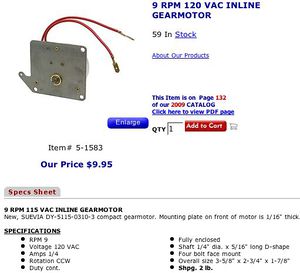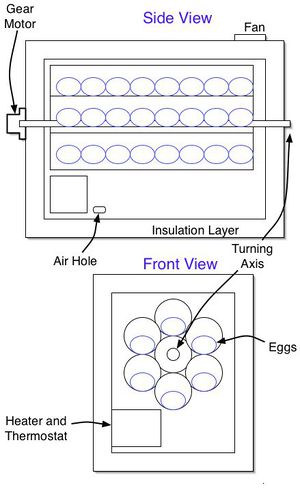Incubator
In order to provide eggs and chickens to Factor e Farm Dream Team 30, we will need to raise our chicken population from 24 to about 300 chickens in 2009. For this, we need to hatch the chickens in an incubator, as natural brooding does not do the trick. We are getting 8 eggs per day even now, and this should increase to about 20. At this rate, it would take us one month of hatching to increase our flock to the needed level. We should aim for an incubator with 48 egg capacity, and do about 5 hatching runs.
Design Rationale
Naturally, hens take care of the eggs by turning them often and sitting on them to maintain the necessary conditions for hatching. The hatchability of eggs in this situation can be variable. Some hens can get 100% hatchability but this is not guaranteed.
An incubator keeps a large number of fertilized eggs safe and warm under ideal conditions until they hatch, ideally with a higher than normal hatchability percentage.
Chickens may be propagated readily from fertile eggs - so freerange chickens can be maintained in a healthy population even in presence of heavy losses to predators. A simple incubator should be available on any diversified farm. Natural chicken birth rates typically happen too late and too infrequently in the season for the chicken population to become self-sustaining. Freerange chickens, which do not require supplemental feeding - could be a great part of a community local food strategy.
The important conditions under the hen are temperature, humidity, ventilation, and turning. The eggs need to be turned for circulation, or else the fluids just sit there.
Research
Resource Map
General Info
- http://www.ext.vt.edu/pubs/poultry/factsheets/8.html
- http://www.associatedcontent.com/article/308949/how_to_hatch_your_own_chicks_from_eggs.html?cat=53
Other Designs
- http://www.msstate.edu/dept/poultry/avianemb.htm
- Constructing a Plywood Incubator - Pictures and BOM. No description. Has an apparently manual egg turner. No motor or timer. Has thermostat with simple wiring diagram.
- http://msucares.com/poultry/reproductions/poultry_make_incubator.html
- http://www.extension.umn.edu/distribution/livestocksystems/DI0631.html
- http://www.backyardchickens.com/LC-howto.html
- http://www.motherearthnews.com/Do-It-Yourself/1982-03-01/Build-Your-Own-Incubator.aspx
Links
Past Work
See Open Source Chicken Incubator
- Critique of past work - manual turning of eggs at least 3 times per day becomes a chore for an integrated human.
Research Summary
- There is a lack of adequate design. University references have no automatic incubator designs. Mother Earth News is the only one with automatic turning, and the mechanism there is unnecessarily complex.
- Infuriated with such nonsense, Marcin proposes HexaHatch.
Design
Humidity and Temperature
- Humidity - $6 analog hygrometer at Amazon -1
- Temperature - two thermometers
- Thermostat and lightbulb for temperature control
HexaHatch Revolution
Hexahatch is a simple, compact, low cost, scalable design incubator with automatic turning via a $10 gear motor.
Design Rationale
- Uses simple on-off wall timer, set for 3 turning sessions per day, 15 minutes long
- Gear motor plugs in directly to timer
- Gear motor is coupled directly to turning shaft
- Symmetry is utilized for low turning torque requirement
- 3" PVC tube (schedule 20) is used for egg holding, arranged in hexagonal pattern
- Inner PVC tube holds turning axle
- Bearings hold axle at ends
- 48 egg capacity
- Thermostat operates a 15W light bulb for heat
- 2" styrofoam insulation is used around box
- OSB is used as a case
- Small fan removes temperature stratification along vertical direction
- Tub of water is found at bottom for humidity
- Incubator opens from the end
- Small air hole is found towards bottom
- Approximate 1x1.5x2 foot box
- Max 60 egg capacity
Bill of Materials
- Wall timer, $8
- Motor with 1/4" shaft, $10
- 1/4" coupler $4
- 1/4" threaded rod $3
- 1/4" nuts, x 6
- 16" of 4", schedule 20 PVC pipe, x 6
- 18" of 4", schedule 20 PVC pipe
- $8
- 4" PVC caps, x 2 $5
- Thermostat, 90-130F range, $10
- Light socket and bulb, $5
- Spare power cords
- 2 metal bushings, $2
- fan
- 2" insulation, 14 square feet, $7
- 20x15" x 2 for front/back
- 20x27" x 2 for sides
- 23x15" x 2 for top/bottom
- OSB shell, $3
- 20x27", x 4 for top/bottom/sides
- 20x21", x 2 for front/back
- 3000 square inches out of 8x4' 4608 sq/in OSB sheet
Total: About $60

